Your feedback so far
Do you have any questions or comments?
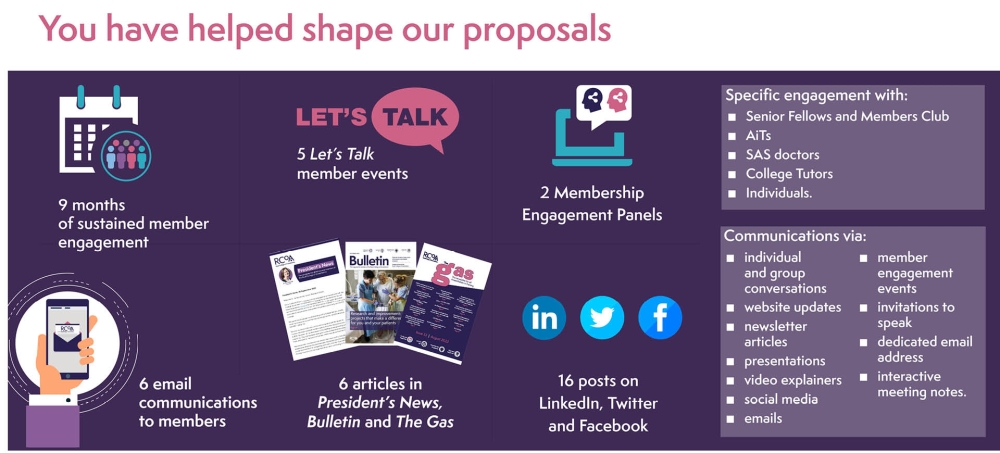
This was the last of our planned Let’s Talk member engagement events via Zoom – many thanks to everyone who came and who added their thoughts.
We heard that this period of member engagement has been really valued and that members have felt a part of the journey.
We asked those present if they felt, at this stage, whether they would We had valuable feedback that representative groups, including the AiT Representative Group, had discussed the proposals and were supportive.
There was a general feedback from in the virtual room that members would support the proposals and were looking forward to the College being able to get on with other important initiatives following the vote.
As always, we asked members present to share what they would like us to take away from this session and their responses are below:
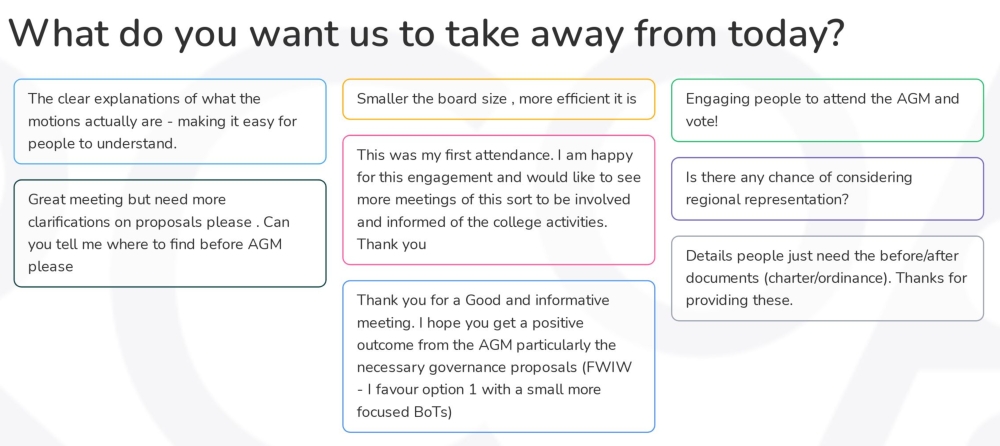
What we heard at the Anaesthetist in Training committee meeting, 17 November 2022
Many thanks to our AiT committee who set aside some time for CEO Jonathan Bruun to go through the proposed changes to governance and explain the next steps. Thanks too to everyone who engaged in the conversation and added their perspectives and questions.
We had some queries that we can share here, along with the answers:
A member of the committee asked whether the wording on the presentation slides Jonathan used was the same as the motions themselves. They are simplified for presentation purposes, but the full text of all the motions, tracked changes, and a numbered change log to make it easier to reference the changes can be seen on the proposals page here.
There was a request for clarification on the options for board composition (option two has places specifically reserved for AiTs and option one does not). Jonathan explained that the College recognised that there were different views about whether representation for AiTs and SAS doctors is needed on the Board of Trustees, and so two options are being presented. The Council, as the body that leads the profession, has two elected and two co-opted AiT members. (Click here for more details).
The College recently conducted a Twitter poll to see if members felt confident they understood the proposals – more than half said that were still not clear. Jonathan said that while the poll was a useful indication it lacked reliability, however we had used the results to share additional information.
There was a question about abstentions to voting being classified as ‘no’ votes, and Jonathan agreed this was the case. This presents problems especially in an online setting when if a member is logged in but away from their screen at the crucial moment of the vote, their non-vote will count against the motion even if they had intended for their vote not to be counted. This is something the College wishes to change going forward, so votes are counted from the cohort present and voting.
What we heard at the Membership Engagement Panel, 15 November 2022
We were really pleased to be joined by members of our MEP from across the UK and internationally for this meeting. We outlined the proposed changes to governance that we will present at the AGM on 1 December 2022 and took the opportunity to ask for members’ feedback.
We heard important perspectives relating to communication methods – we realise that the subject of governance can be complex and takes time to understand and so we were interested to hear if the messages had been getting through and if we had been clear.
We spoke about emails (and the burden on inboxes) and the less direct channels like WhatsApp groups as a reminder and the use of the LLP.
At the time of the meeting, we had 250 people signed up to attend the AGM, of which 40 are anaesthetists in training. The MEP members present said they were pleased to share the message in the WhatsApp group.
While the College has been updating information online, not all MEP members had seen it and so we know we need to make sure members and especially those attending the AGM had clear signposting.
Attendees heard about the difference between the Board of Trustees and the Council, and the representation from across the regions that is already the case on Council. (We have more information on this link).
We also spoke about the current requirements for elected Council members to take on the additional responsibilities of being a Trustee and what this meant in practice – with examples from elected members Sarah Ramsay, SAS doctor Sunil Kumar and AiT Rashmi Rebello.
Meeting attendees discussed appropriate training for the Board of Trustees, and Fiona was able to reassure that this was in place.
There was a question about the motion to involve members, and how it would be possible given that there is 26,000 members of College and Faculties. Fiona was able to clarify this; the motions are to give members appropriate powers such as the power to bring a motion to the AGM, to be able to vote by proxy, to be able to remove Council members and to make changes to the governance. (The information on this page refers).
The meeting also raised a question about modernisation documents, pointing out that the College was already very advanced in its thinking. Jonathan clarified this related to being explicit about terms that had not been widely used when the governing documents were drawn up, like ‘perioperative medicine’ in the definition of the specialties of the College, and also to change the reference to the monarch from Queen to King.
As with previous events, we asked members to write down what they wanted the College to take away from the discussions.
As well as the governance comments in the screenshot below we also had feedback that the College needed to do more regarding regional representation generally. Although the comment was not specific to governance, we were pleased to show that the regional representation on our Council with specific places for the Ireland, Wales and Scotland board chairs and an additional regional representative.
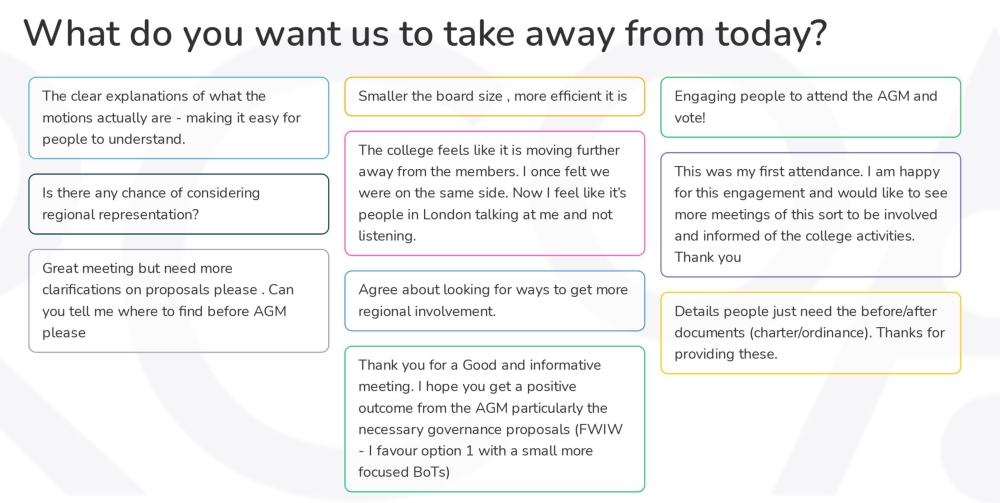
What we heard at Let’s Talk, 18 October 2022
We were so pleased to be joined by Dr Suzie Thoms and Dr Soumen Sen for this Let’s Talk. Suzie and Soumen were able to offer an important perspective from an anaesthetist in training point of view, and some good suggestions for how we communicate the governance proposals.
We spoke about the need for short communications and signposting, the method of sharing information via messaging channels as well as email and social media, and to make it clear what we are asking and how changes will benefit members.
With that brevity in mind, we will ask Suzie and Soumen to share the AGM booking link and a covering message to their WhatsApp groups. Our elected SAS council member Dr Sunil Kumar also attended the meeting and will share in his SAS groups as well.
Our Council members will also be conducting their own presentations in their departments, and with the brevity in mind we will make sure their slides and materials are an overview rather than a deep dive – however, for those of you who want greater detail we will make sure that is available on our webpage.
We discussed the recent decision of the College Board of Trustees to present two models for future Board composition to the AGM. Read more.
What became clear was that as well as describing the future Board of Trustees compositions, we also need to clear about the role of the Board versus the role of the Council, and to provide reassurances that the Council is representative of the members. This is something we will address in future communications.
As with our previous sessions, we asked attendees to tell us what they wanted us to remember from the session:

What we heard at Let’s Talk 20 September 2022
Our President Dr Fiona Donald wrote to all members and fellow on 20 September to explain the decisions and a copy of that email can be seen here.
Immediately following that communication, we held a Let’s Talk event online. A registration list of 70 people for our membership engagement Zoom session on 20 September 2022 and 35 people involved in the discussions. The meeting was chaired by Vice President Dr Helgi Johannsson.
We confirmed some decisions that we have already made based on member feedback, as outlined by President Dr Fiona Donald’s message to members earlier that day; we have decided that rather than asking you to support a single motion as we did at our February 2022 EGM, we will split the voting into smaller linked but independent proposals, and also present options for a potential Board of Trustee composition.
We spoke about people’s understanding of the College being a charity and what that means for us and the way we are governed, and – indeed - why we are a charity in the first place.
All Royal Medical College are charities, and we have been a Charity since our inception. Our status as a charity is mirrored in our Royal Charter and our ultimate goal of serving the public. It also has financial benefits that other organisations cannot access, such as different taxation levels, preferential rates, and the ability to raise funds.
We spoke about the roles of Council compared with the Board of Trustees, and the fact that we have had both of these bodies in place since the last governance review in 2018. However, at that time errors in the drafting that meant that Council members were automatically Trustees, which was never the intention.
The responsibility of the Board of Trustees is for financial and organisational management and the delivery of the College’s charitable objects, whilst the Council leads the specialty and takes decisions on professional issues. Whilst it was the intent in 2018 for these groups to be different, the errors mean they are made up of largely the same people.
We are grateful to everyone who shared their view on this, including the experiences of former Council members. We heard about the time pressures on elected members in completing both roles, the personal responsibility for College finances and management that comes with being a Trustee, and the need for accountability which is difficult when scrutinising one’s own work.
There were questions about whether the Board of Trustees would have the power to remove elected representatives on Council (they would not), whether we need to remain a Charity (we do) and we heard a plea to make the distinction between the role of the Council and the role of the Board of Trustees clearer.
Thank you too to everyone who gave a view on our thoughts for options for a new Board of Trustee composition. At present, we have 29 members of the Board, made up of all 24 elected full Council members, three lay members and the two Deans of our faculties.
We spoke about whether we needed to bring in sector expertise to the Board of Trustees to advise on aspects like finance and business management, which are arguably not the focal points of our elected members, and what that might look like. There was broad support for a ‘lean’ version of the Board, and your clear steer was that you would still expect there to see the majority of Board members being from our specialties.
As with our previous Let’s Talk on Governance, we asked attendees to tell us what they wanted us to remember from the session:
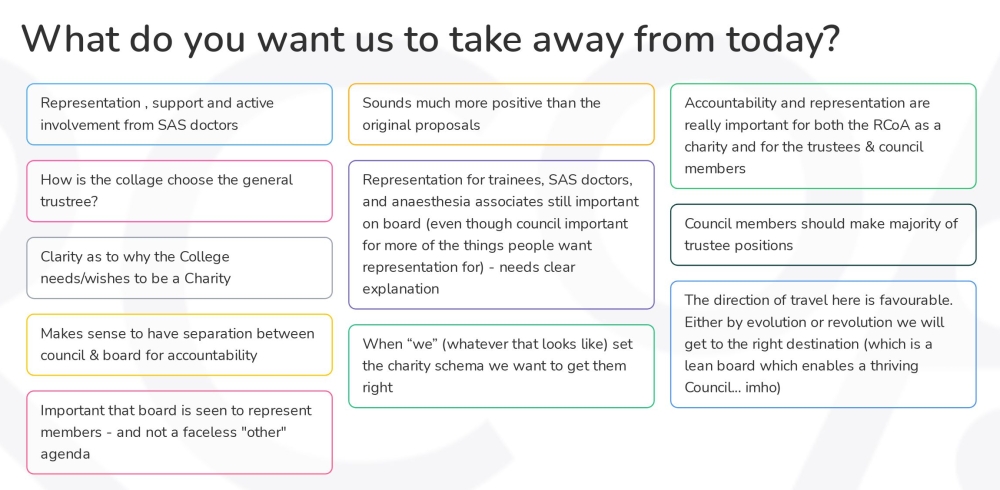
What we heard at Let’s Talk 14 June 2022
More than 80 members and fellows registered for our Let’s Talk member engagement Zoom session in June, and on the night we had 34 people involved in the discussions.
We discussed the issue of being a Charity and what this entails. As a Charity we are bound by the requirements of the Charity Commission, and we have Charitable objectives (see here to read them on the Charity Commission website).
We have a Board of Trustees and a Council – two groups of equal stature but with different responsibilities and focus areas. However, in practice, these two groups have a large overlap with all 29 elected members also serving on the Board (this is one of the areas we wish to address – we want to have representation from key groups on the Board but also have it small enough to have the right level of scrutiny).
Representation on Board and Council was discussed in depth, including who needed to be represented where and the expectations on time for members of either group. We heard support and advocacy on behalf of a number of specialty groups, including anaesthetists in training, SAS doctors and anaesthesia associates.
We asked those attending to tell us, anonymously, what they wanted us to remember from the session:
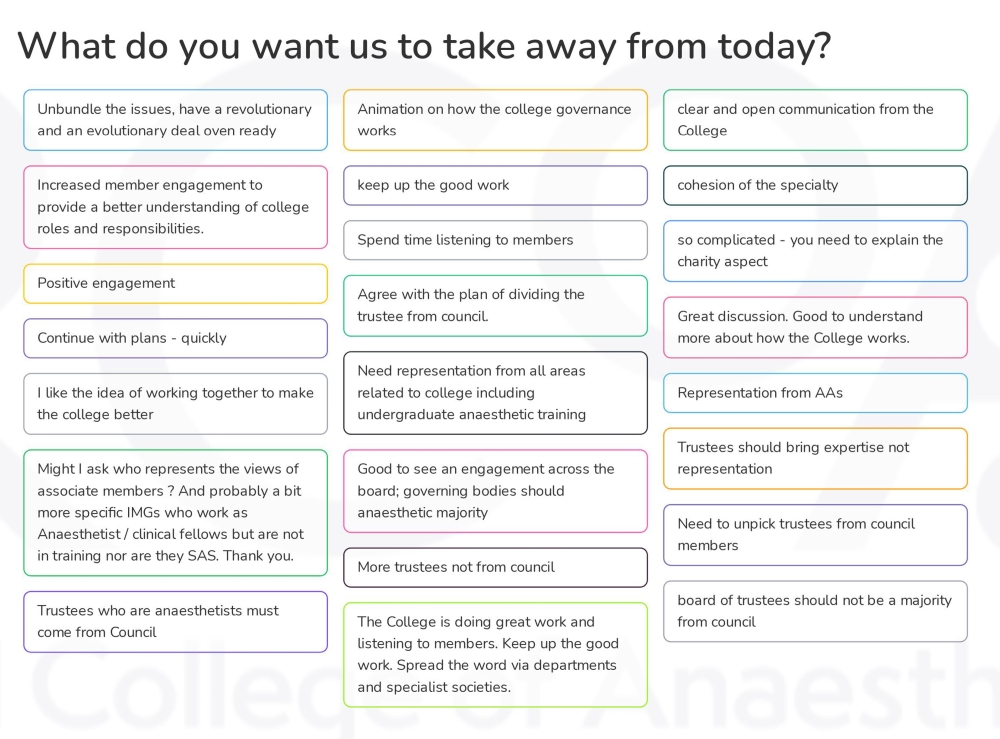
We spoke also about the previous EGM where we had put a single proposal to change our structures and give more power to members. We heard that having a single proposal was not popular, and you advised us to have options or incremental positions. This may not be possible in practice as everything is so interlinked – however, we take the overall message of this as that we need to discuss each point in turn and to make sure interrelated aspects are aligned and balanced appropriately and that you have had a chance to input into all the aspects.
